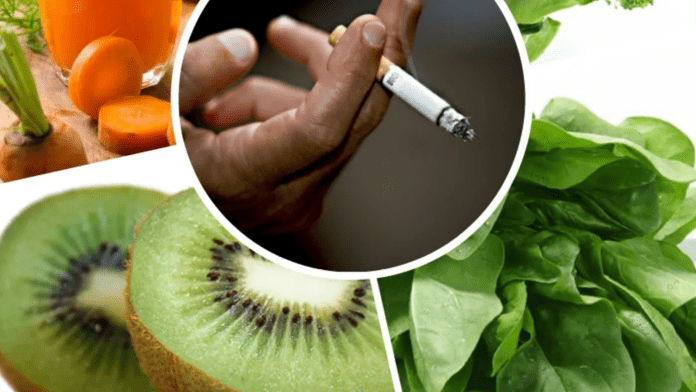Quitting smoking is a challenging endeavor that requires determination, willpower, and support. While there are various strategies and aids available to help individuals quit smoking, such as nicotine replacement therapy and counseling, the role of diet in smoking cessation is often overlooked. World No Tobacco Day serves as an opportune moment to explore the connection between smoking and diet and shed light on the ten most effective and detrimental foods for quitting cigarettes.
The Link Between Smoking and Diet
Smoking is a habit that not only affects the lungs but also influences overall health and well-being. Research has consistently shown a link between smoking and poor dietary choices. Smokers tend to consume fewer fruits and vegetables while consuming higher amounts of processed foods, sugary beverages, and alcohol. These dietary habits not only exacerbate the negative effects of smoking but can also impede smoking cessation efforts.
The Role of Food in Quitting Smoking
Food can play a crucial role in the journey of quitting smoking. Certain foods can help reduce cravings, alleviate withdrawal symptoms, and make cigarettes less appealing, while others can act as triggers, making it more difficult to resist the urge to smoke. By understanding the impact of different foods on smoking behavior, individuals attempting to quit can make informed choices to support their journey toward a smoke-free life.
10 Best and Worst Foods for People Trying to Quit Cigarettes
- Best: Milk
One surprising food that can help deter individuals from smoking is milk. In a study published in the journal Nicotine & Tobacco Research, researchers discovered that dairy products, particularly milk, interact with the taste of cigarettes, making them less palatable. The study found that consuming milk before or during a smoking episode can lead to a distasteful experience. It is important to note that this effect applies only to nonmenthol cigarettes, as menthol can mask various flavors.
- Worst: Coffee
Unlike milk, coffee and cigarettes often go hand in hand for many individuals. The act of having a cigarette with a cup of coffee becomes deeply ingrained in smokers’ routines and creates a psychological association between the two activities. Additionally, the stimulating effects of caffeine can enhance the buzz from smoking, making coffee a strong trigger for cravings. Breaking this association by substituting coffee with tea for a period can help diminish the urge to smoke when consuming hot beverages.
- Best: Fruits and Vegetables
Increasing the consumption of fruits and vegetables can be highly beneficial for smokers attempting to quit. Smokers typically consume fewer fruits and vegetables compared to non-smokers, and boosting intake during the cessation process can have positive effects. Research published in the journal Nicotine & Tobacco Research found that individuals who ate more fruits and vegetables were three times more likely to have stayed smoke-free for at least 30 days compared to those who ate fewer servings. Furthermore, fruits and vegetables can worsen the taste of cigarettes, making them less appealing. When experiencing tobacco cravings, the Mayo Clinic suggests reaching for raw carrots or other crunchy and tasty snacks. Chewing on pickles, apples, or celery can also keep the mouth busy and help counteract the psychological need to smoke.
- Worst: Alcohol
Alcohol and smoking are often intertwined, with the two habits reinforcing each other. People commonly associate having a drink with lighting up a cigarette, and the combination becomes automatic. Moreover, like coffee, alcohol can enhance the taste of cigarettes, further strengthening the association. To minimize the risk of relapse, it is recommended to abstain from alcohol during the initial smoke-free month. Afterward, individuals should limit their alcohol intake to avoid impaired judgment and increased vulnerability to reaching for a cigarette.
- Best: Popcorn and Other Snacks
During the quitting process, individuals may experience increased snacking urges due to the absence of cigarettes. Snacking can help keep the hands and mouth busy, and opting for low-calorie options like air-popped popcorn can be beneficial. Popcorn not only helps distract from the urge to smoke but also satisfies salty cravings and provides a feeling of fullness. Other recommended snacks include sunflower seeds, sugarless gum, or hard candy.
- Worst: Meat
Interestingly, the taste of cigarettes can be enhanced by consuming meat products. Similar to coffee and alcohol, meat can make smoking more appealing. By being aware of this association, individuals attempting to quit can make conscious choices to minimize their intake of meat and decrease the likelihood of triggering cravings.
- Best: Cinnamon Sticks
While not recommended for consumption, some individuals find that sucking on cinnamon sticks offers a satisfying taste without the caloric intake. This alternative can serve as a distraction and provide something to chew on or play with, keeping the hands occupied during the quitting process.
- Worst: Spicy and Sugary Foods
Spicy and sugary foods can increase the desire to smoke, making them detrimental for those trying to quit. The American Cancer Society advises avoiding these types of foods during the smoking cessation journey as they can intensify cravings. By minimizing the consumption of spicy and sugary foods, individuals can reduce the likelihood of relapse.
- Best: Beans
Quitting smoking is often associated with weight gain due to the replacement of cigarettes with food. Additionally, the appetite-suppressing and metabolism-enhancing effects of nicotine cease, leading to increased hunger and potential weight gain. To combat this, incorporating high-fiber foods like beans into the diet can be beneficial. A study published in the Annals of Internal Medicine demonstrated that increasing fiber intake resulted in weight loss. Beans, artichokes, broccoli, raspberries, and oatmeal are all excellent sources of dietary fiber.
- Best: Your Favorite Food (in Moderation)
Once individuals successfully quit smoking, their senses of taste and smell are significantly enhanced. This heightened sensory experience provides an opportunity to reconnect with beloved foods that may have been less enjoyable while smoking. Enjoying favorite foods in moderation allows ex-smokers to savor the flavors and derive pleasure from meals without compromising their smoke-free journey.
Quitting smoking is a challenging process that requires dedication and support. By understanding the impact of different foods on smoking behavior, individuals can make informed choices that aid in their journey toward a smoke-free life. Milk, fruits and vegetables, and snacks like popcorn can be helpful allies, while coffee, alcohol, and certain foods should be approached with caution. Incorporating high-fiber foods like beans into the diet can assist in managing weight gain, and enjoying favorite foods in moderation can provide moments of pleasure throughout the quitting process. By harnessing the power of a well-balanced diet, individuals can improve their chances of successfully quitting smoking and embark on a healthier, smoke-free future.





